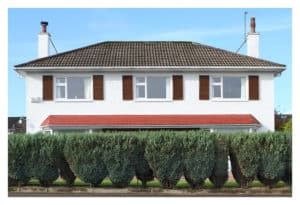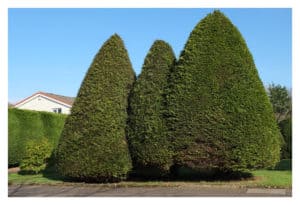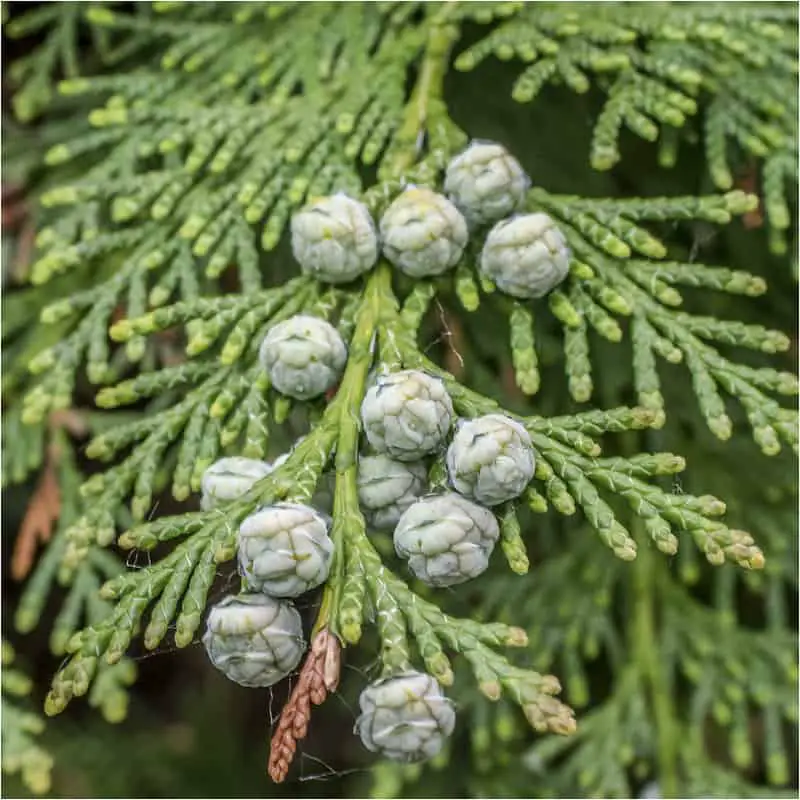When choosing the best wood for your wood stove, there’s a lot of factors to consider, including
- whether the wood is poisonous
- it’s an endangered species
- or whether it’s overly sparky
- ….among other factors.
Leylandii wood is very common in western Europe and North America.
Your wood merchant may be having plenty of it in the store. Because this wood belongs to the fir family (it’s actually a kind of cypress) hence a softwood, it is easy to assume it won’t perform well in the oven.
Can You Burn Leylandii Wood In A Wood Stove?
Certainly YES. Leylandii wood is one of the most sought after woods out there among wood stove owners. If you happen to cut down your Leylandii hedge, don’t forget to keep every bit of the wood for your stove, especially if Winter is approaching. You could be surprised – Leylandii wood burns with a cracking sound and will last a long time as well. It burns perfectly and fills the stove with plenty of red hot coals that lasts for ages even after the flames have died down.
What Is The Biggest Benefit of Leylandii Wood?

Perhaps the biggest benefit of this wood is its low smoke signature – very little smoke is produced, leaving the glass of your stove clean the whole time.
Chuck one knotty lump on the produced embers before retiring to bed, and it will turn the air right down and still burn till the morning.
It can be surprising to some users considering that Leylandii is not regarded so highly as other popular woods (although it’s still known to be a decent wood for the job).
So, if you are used to keeping it just because you don’t like chucking away appropriately sized wood away, it’s time to have to make a switch.
Remember to Season Your Leylandii Wood
- It can’t be emphasized enough that the secret to good wood and, therefore, a great fire is a heap of well-seasoned logs.
- Leylandii wood performs better when seasoned. Note that seasoning can only occur with dry conditions and time.
The water content in freshly cut Leylandii logs is normally between 45 and 50 percent. - Well-seasoned Leylandii firewood tends to remain with just 20 – 25 percent moisture content.
What Are The Four Benefits Of Seasoning Leylandii Wood?

Here are the benefits of ensuring your Leylandii logs are well seasoned before piling them in your stove:
1. Poorly seasoned wood will burn inefficiently and slowly
Part of the generated heat will be used to dry out your Leylandii wood before it starts to burn completely.
The fire won’t be hot enough and is more likely to produce considerable smoke.
The generated smoke has two setbacks:
- it makes the glass on your stove dirty
- and contains more particulates and some complex hydrocarbons that reduces the efficiency further.
2. Because unseasoned Leylandii wood will certainly produce a significant amount of smoke, it can qualify as a pollutant just like any other unseasoned wood
Dry firewood will normally produce very little smoke.
Also, they will burn completely with a hot flame to release carbon dioxide and plenty of heat.
Less smoke means fewer particulates, thus less pollution.
3. Well-seasoned Leylandii wood is perfect for your chimney
As aforementioned, one of the major drawbacks of burning unseasoned logs is a cooler flame and more smoke.
A cooler fire means the chimney won’t heat up as needed.
A cool chimney or chimney flue often result in unwanted condensation of the destructive volatile components of the smoke, which ends up accumulated on the inside of your chimney.
The resultant deposit typically consists of creosote – a flammable substance formed from unburnt smoke particles.
But why be concerned with Creosote accumulation?
If allowed to build up in the chimney, creosote can eat into the linings of the walls of your chimney. This can mean a reduced lifespan of the chimney.
4. Well-seasoned Leylandii wood helps cut the chances of chimney fires
Because unseasoned wood can accelerate the rate of deposition of unburnt chemicals on the chimney’s lining, there is a strong chance that these deposits may re-ignite, causing fires in the chimney.
Not only can it damage the chimney, but it may also cause it to spread even faster throughout the structure and even lead to house fires.
Here Are Thirty Six Other Wood Types That Can Be Supplemented With Leylandii Wood
Are you looking for a wood that you can supplement Leylandii with? Consider this range:
- Alder: Opinion on this type of wood varies, but works superbly when well-seasoned.
- Ash: One of the best burning woods out there; has both a superb heat and great flame and will burn perfectly even when green because the moisture content is low.
- Apple: Apple is known to burn slowly and steadily if you especially if you are dealing with the driest logs you could find. The flame is normally little, but the heat is satisfactory. The scent is also pleasant. Must be seasoned to produce full benefits
- Birch: The heat from birch wood is good but has a reputation for burning quickly with a brilliant/bright flame. This, too, smells nice. It burns well when accompanied by slow-burning woods.
- Beech: Beech burns best when well-seasoned
- Cedar: This wood is great when dry. It burns with a small flame, but the heat is normally satisfactory. The scent is attractive too.
- Chestnut: The only wood on this list we can describe as mediocre. It is also prone to shooting embers. Both the size of the flame and heat are disappointing but are better than nothing.
- Cherry: Chery burns slowly, but with a good heat. The scent of cherry is great and doesn’t spit fire.
- Cypress: Being a softwood from the fir family (the same family with Leylandii), it burns perfectly but very fast when seasoned. It also comes with oils, which makes it prone to spitting.
- Douglas Fir: Little flame but a relatively impressive heat.
- Elm: For Elm wood to burn well, it needs to be left to dry for two years or more. It will still smoke after this period. It also contains more water.
- Hazel: Perfect wood burns fast and efficiently without spitting out. It is too valuable for many carpentry applications that might make you feel guilty to burn it in the stove.
- Hawthorne: Two words – “it burns well.”
- Holly: Great wood. It will burn even when green, but the results are normally better when seasoned.
- Horse Chestnut: Good heating power and flame but spits a lot.
- Hornbeam: Good wood. It burns well
- Laburnum: We felt the need to mentioned this wood because it’s common and it’s highly poisonous. It produces acrid smoke and will taint surfaces.
- Laurel: Burns with a brilliant flame.
- Larch: Spits and crackles, but pleasantly scented. It also releases great heat and a brilliant flame. Often leaves oily soot in chimneys.
- Lime: Poor wood. Burns with a dull flame, but the scent is pleasant.
- Oak: Dry oak wood is one of the most excellent oven woods out there. It burns slowly and steadily, accompanied by a good heat. However, you will need to season it for between 2 and 3 years.
- Maple: Good wood for a wood stove
- Pear: Burns slow and steady. It produces a good scent and a satisfying heat.
- Plane: Burns pleasantly. The only drawback of this wood is its tendency to throw sparks, especially when very dry.
- Pine: Burns with a brilliant, splendid flame. It is also prone to spitting. Pinewood demands thorough seasoning. Gives off plenty of resins.
- Plum: Good scent and heat
- Rhododendron: With its thick old stems and toughness, it burns unsurprisingly well.
- Poplar: Burns with a little heat very slowly
- Robinia (Acacia): This wood is rare in North America. It burns slowly but with great heat. On the downside, it produces considerable smoke.
- Spruce: Burns too fast and with many sparks.
- Rowan: Burns well
- Sycamore: The flame of this wood is impressive. The heat is moderate but can be useless when green.
- Sweet chestnut: Burns perfectly when seasoned but will send out sparks. It is recommended you only use sweet chestnut when the door of the stove is closed.
- Walnut: Burns well and comes with a good scent. The best choice if you cherish aromatic woods
- Yew: Among the best firewood out there. Burns slowly, but with a fierce heat. The scent is also pleasant.
- Willow: Can only be used when very dry. It burns slowly with a small flame. It is prone to sparks.
In A Nutshell
Can you burn Leylandii wood in a wood stove?
Yes. Leylandii wood is one of the most sought after woods out there among wood stove owners.
If you happen to cut down your Leylandii hedge, don’t forget to keep every bit of the wood, including than tip, for your stove, especially if the winter is approaching.
You will be surprised by the wood’s ability to burn with a cracking sound and will last a long time as well.
It burns perfectly and fills the stove with plenty of red hot coals that lasts for ages even after the flames have died down.


